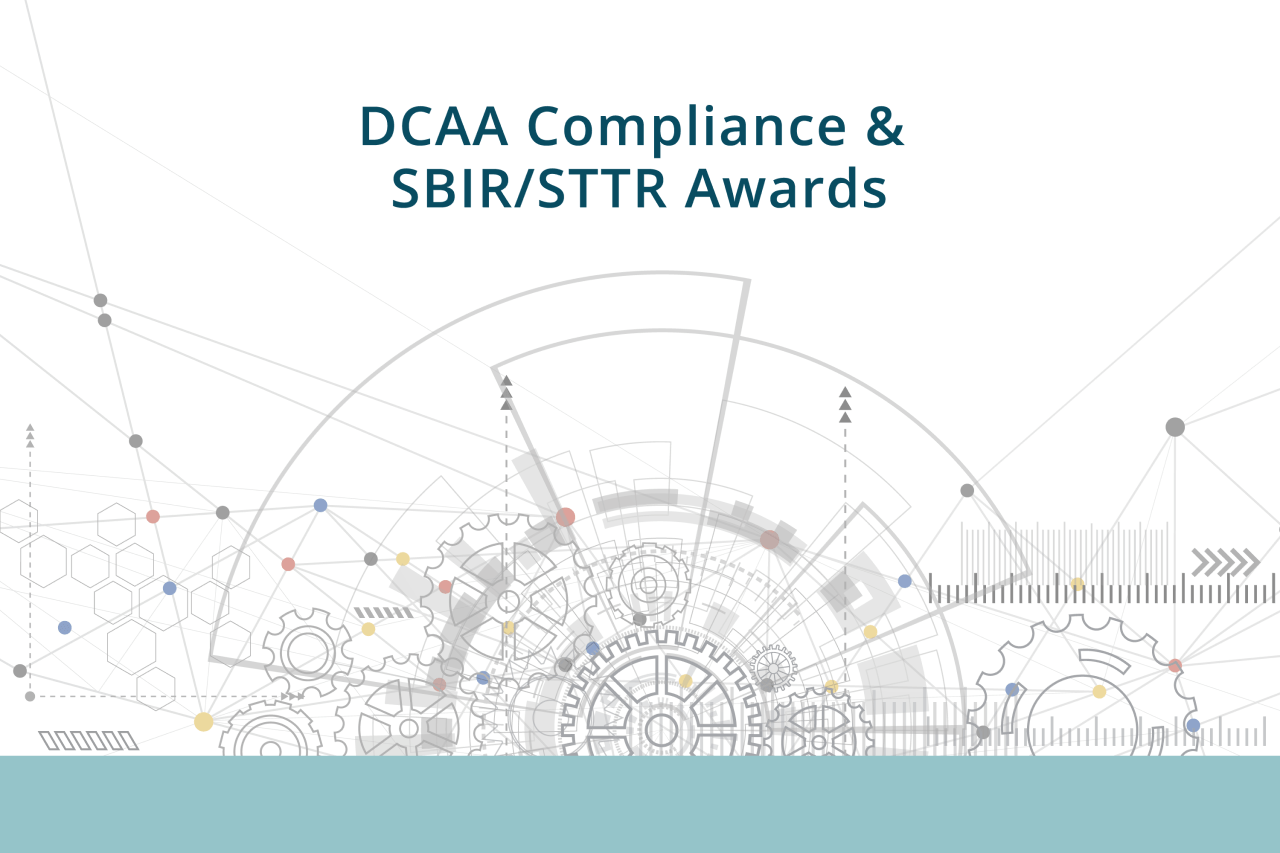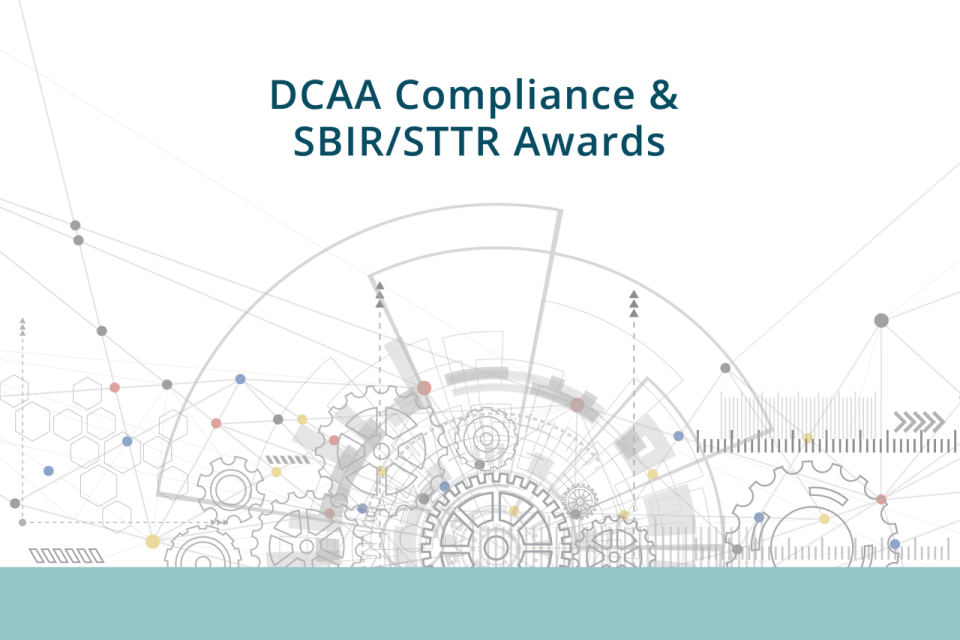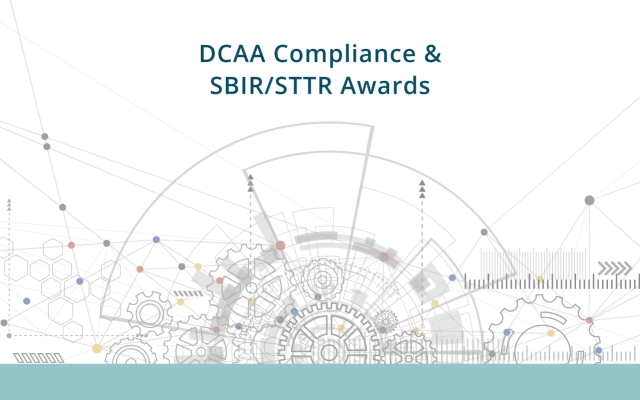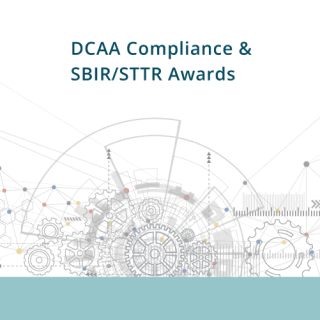



How to prepare your accounting system for SBIR awards and follow-on contracts
What small businesses need to know about adequate accounting systems
If you’re new to SBIRs, or government contracting more generally, you will be well served to understand the implications of winning an SBIR award on your accounting practices. Preparing early to ensure a compliant accounting system can help you avoid delays and set your business up for success in doing business with the Federal Government.
In this article we’ll share what you need to know:
- When you need a compliant accounting system
- What are the requirements of an adequate accounting system
- How you can prepare your accounting system for a future audit
When do you need a compliant accounting system
SBIR/STTR program requirements vary by agency
Small Business Innovation Research (SBIR) / Small Business Technology Transfer (STTR) funding opportunities, amounts, and programs vary by Federal Agency. If and when you need a compliant accounting system will depend on the agency program requirements and the nature of the funding. You can explore the participating Federal Agencies and their SBIR Programs on the SBA’s SBIR website. Budget requirements for SBIR/STTR proposals will also vary by agency program.
The largest SBIR/STTR program is under the Department of Defense, currently funding $1.9 billion in small business contracts annually. Phase II awards under DoD will typically require a compliant accounting system, as do some follow-on contracts. DoD's program focuses on the acquisition of solutions to meet the needs of the agency. You can find the current open topics on the Defense SBIR/STTR Innovation Portal.
You can view current topics and past awards for all agencies on SBIR.gov. Specific funding solicitations will provide instructions, requirements, and guidance for the application/proposal.
Contract type will drive accounting system requirements
Contract type governs the timing of the Government’s due diligence in evaluating contract pricing, and how contractors invoice the Government on Federal contracts.
In most cases, Phase I is awarded as a Firm Fixed Price (FFP) contract. Because the award amount is relatively small, and due diligence is performed prior to the award of the contract, the accounting system is typically not subject to an audit at this stage.
For Phase II, as the dollar value increases the contract type often shifts to a Cost-Reimbursement Type contract (e.g. a Cost-Plus Fixed Fee, or CPFF), or a fixed price contract that involves progress payments.
With cost-reimbursement type contracts, due diligence on pricing is done not only during the proposal phase, but also at the end of each contract year. An estimate of total contract costs is established and a funding ceiling is set on the front end. Allowable costs incurred may be reimbursed to the extent provided by the terms of the contract. At the contractor’s fiscal year end, the variance between the interim amounts invoiced through the year and the actual allowable costs incurred is settled.
As a pre-condition of the contract award, cost-reimbursement type contracts include the requirement under FAR 16.301 that the contractor’s accounting system is "adequate for determining cost applicable to the contract."
What are the requirements of an adequate accounting system
Where can I find the accounting system requirements?
Prospective contractor accounting systems are evaluated using the Preaward Accounting System Adequacy Checklist, also known as Standard Form 1408. This checklist outlines the criteria necessary to satisfy the FAR and DFARS requirements and pass the audit.
Who is DCAA?
The Defense Contract Audit Agency, or DCAA, conducts this Preaward Accounting System Survey for DoD SBIR/STTR contracts, and for some other agencies as well. DCAA details the audit process and expectations in a publication entitled Information for Contractors, available for download on their website. Enclosure 2 of that publication, Preaward Surveys, provides the specific guidance on the audit process and accounting system requirements. Contractors should become familiar with its contents.
What does DCAA audit?
To properly prepare for an accounting system evaluation pursuant to SF1408 – whether it is to be conducted by DCAA, a civilian agency auditor, or an independent auditor – you need to carefully consider the design and operation of your accounting system. It is important to note that the software application is only part of the overall accounting system.
The Preaward Accounting System Review is an evaluation of the design effectiveness of your accounting system prior to contract award. In short, you will need to demonstrate:
- Your accounting system design supports the adequacy criteria on SF1408
- Reports and general ledger examples validate your accounting system design
- You maintain a general ledger based accounting system with requisite internal controls and documentation that support the reports generated by the accounting system
- Written policies and procedures document how your accounting system is structured and used
4 Things You Should Prepare Now for a Future Audit
To qualify for SBIR Phase II and other cost-reimbursement type contracts, you will need to pass a pre-award accounting system audit. To pass, you will need to demonstrate that your accounting system satisfies the requirements outlined on Standard Form 1408.
It’s never too early to begin planning for and implementing several key elements.
1. Segregate Direct Costs from Indirect Costs
One fundamental requirement of Federal contract cost accounting is the segregation of direct costs from indirect costs.
For small businesses using QuickBooks as their accounting system, the proper segregation of direct costs from indirect costs can easily be achieved by organizing the chart of accounts into cost pools, with the direct costs contained in its own pool, separate from the various indirect cost pools.
Direct costs are costs incurred specifically for the contract. A top level account for direct costs, with sub-accounts for the various direct cost elements, serves to group these contract-specific costs while segregating them from indirect and unallowable costs.
Likewise, indirect costs, which can support contract performance but can be assigned to more than one single contract (overhead costs) or are necessary for the overall business operation but do not have a direct relationship to a specific contract (G&A costs), should be accumulated in cost groupings, or cost pools, that reflect the reason behind incurring such a cost. Common top level indirect cost pools are Fringe, Overhead, and General & Administrative (G&A).
Consider whether your current account groupings segregate the various costs and assign them into logical cost groupings now to prevent having to significantly re-organize your chart of accounts later.
2. Make sure you have a compliant Timekeeping and Labor Distribution System
For many contracts, labor is one of the most significant types of costs incurred. Labor also has a significant role in determining your indirect rates. Consequently, timekeeping is a critically important part of a compliant accounting system.
Why does timekeeping attract more scrutiny? For most transactions, you will have some form of outside documentation to substantiate the cost – a receipt, an invoice, a lease agreement. For labor, the documentation is internally generated, and that leads to increased oversight for compliance in this area. DCAA’s Information for Contractors, Chapter 2, discusses the Labor Charging System, including timekeeping procedures, timesheet preparation, timekeeping policy recommendations, and internal controls.
Whether you’re using a web-based timekeeping system with alerts and internal controls, or an old-fashioned pen and ink method, it’s vital that you and your employees adhere to adequate, accurate timekeeping procedures. A key element of an acceptable timekeeping system is the independent responsibility of the employee in maintaining his/her own timesheet. Realistically, this may take some getting used to. Time should be entered daily, for everyone in the company. All hours worked should be recorded, whether paid or not, even if more than 8 hours. Employees should be regularly reminded of the timekeeping policies and procedures. Getting your team into a new timekeeping routine early helps ensure you have the proper documentation to substantiate costs and your indirect rates.
The labor distribution system charges direct and indirect labor to the appropriate cost objectives. You will need to ensure your labor distribution system accurately documents direct and indirect labor hours and costs by employee, by cost objective or contracts, and by indirect accounts. Labor distribution records reconcile to payroll and timesheet data, and to job cost and general ledgers.
3. Exclude Unallowable Costs
There are certain costs that the Government will not reimburse. Such unallowable costs can be segregated out in the chart of accounts to ensure they are not charged directly, or allocated through an indirect cost pool, to the contract.
Contractors should be familiar with FAR 31.205 and be prepared to demonstrate an understanding of which costs are unallowable. It’s worth noting that in addition to the FAR guidelines, the terms of the contract may further define allowability and some SBIR/STTR agencies have supplemental regulations for certain costs, which can mean either more limits or greater allowability.
What internal controls do you have in place to ensure unallowable costs are not charged to the contract?
4. Document Your Policies and Procedures
Contractors should expect to provide the auditor with a written narrative explaining how your company’s policies and procedures achieve compliance with the accounting system standards specified on the SF1408. Your policy and procedure statements should address internal controls and issues relevant to adherence to generally accepted accounting principles. Policies and procedures should also detail how indirect costs will be accumulated and allocated, the segregation of direct costs from indirect costs, how costs are accumulated under general ledger control, timekeeping and labor distribution processes, and the exclusion of unallowable costs, among other topics.
Documenting your current design and operation of your accounting system will help you and your team to address the necessary requirements for compliance and provide a framework for updating those operating procedures if your business needs change ahead of your audit.
___
Why should I invest time and effort in my accounting system?
The consequence of not having your financial house in order can mean a significant funding delay between Phase I and Phase II. Planning ahead helps ensure you will be ready to proceed to the next phase of SBIR funding. It also positions your business to qualify for follow-on contracts with the Federal Government.
One Phase II awardee called us for assistance with his accounting system, and admitted he was shocked by how soon the auditors were calling. Following his successful DCAA preaward survey, he had his Phase II funding award in a matter of weeks. That quick turnaround set his business up for success – by both delivering on the mission of the agency he was working with, and investing in the innovative technology his business was developing.
ICAT gives small business government contractors a quick, affordable, and easy-to-use solution that enables growing companies to meet the requirements of an adequate accounting system. Explore ICAT's cost accounting and reporting features, and learn how ICAT fills the gap for DCAA compliance using QuickBooks.
Keep Reading
What is Standard Form 1408?
What you need to know about Standard Form 1408 and the preaward accounting system review.
How to Set Up an Indirect Cost Pool Structure in QuickBooks
How to structure a QuickBooks chart of accounts for government contracts and DCAA compliance.